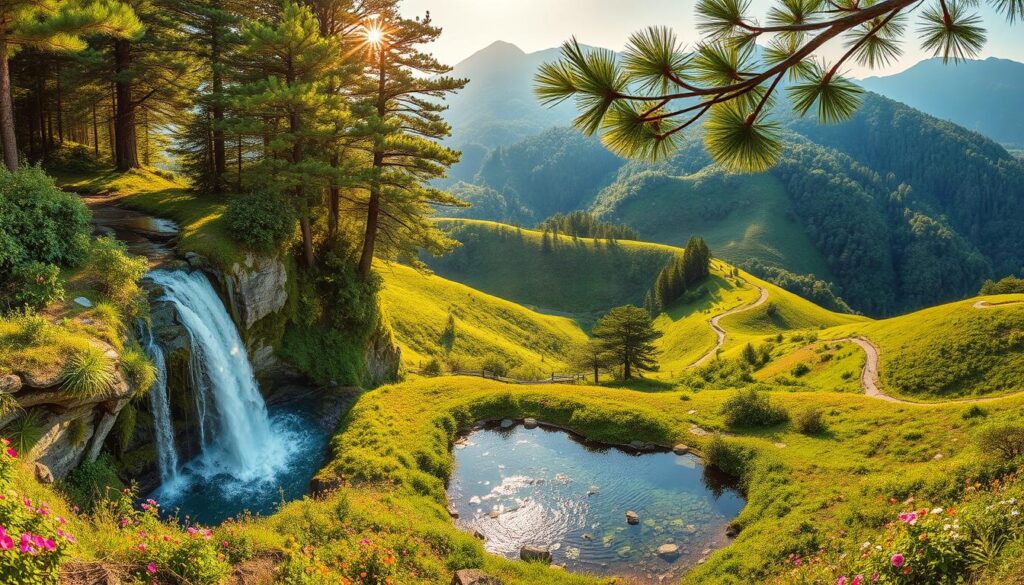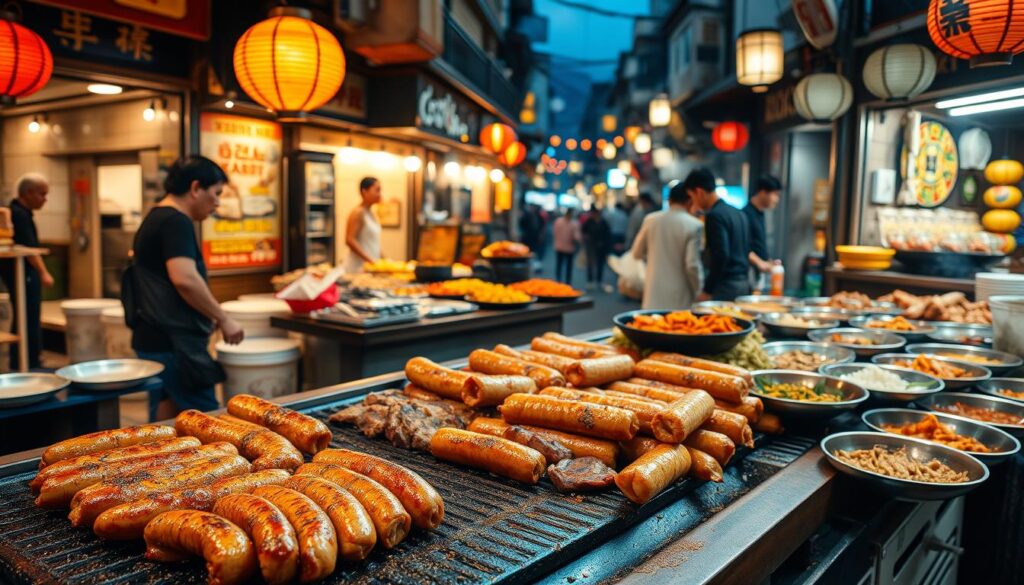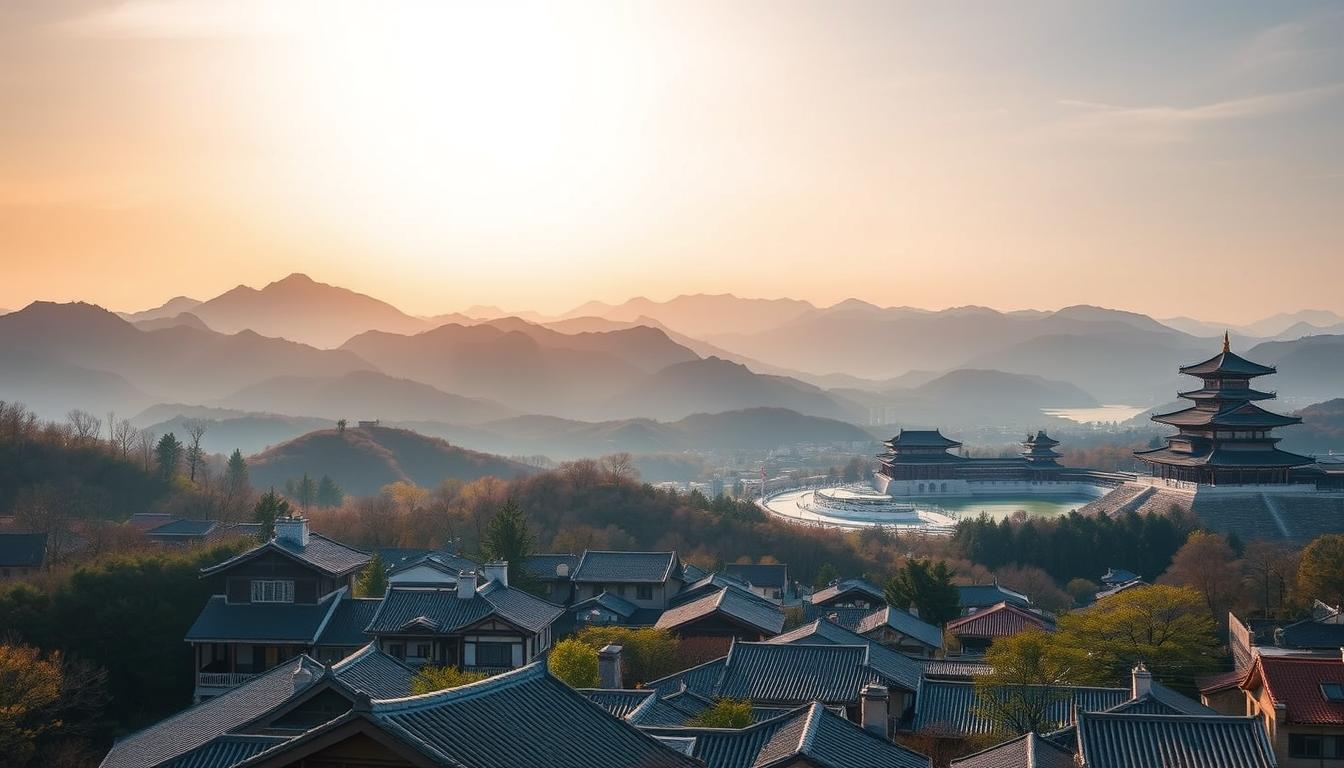Top Things to Do in South Korea: Best Thing to do for 2025
Table of Contents
Imagine stepping into a world where ancient traditions meet modern technology. In South Korea, you’ll find landscapes that are both historic and exciting. Your journey here will be filled with unforgettable moments in both nature and cities.
South Korea is covered in over 70% green mountains and forests. It offers endless activities for all kinds of travelers. From Seoul’s busy streets to the calm coasts, you’ll see a mix of culture and innovation.
In Seoul, you can visit royal palaces and try street food. South Korea has more to offer than just the capital. You can also explore volcanic islands, historic villages, and national parks.
South Korea has something for everyone, whether you love history, nature, or culture. Get ready to be amazed by a place that combines old traditions with new culture.
Exploring Seoul’s Royal Heritage
Seoul’s royal palaces take you on a journey through Korea’s rich history. These architectural wonders are among the top places to visit in South Korea. They offer a glimpse into the Joseon Dynasty’s grandeur.
Seoul’s royal heritage shows Korea’s deep cultural roots. The city has five grand palaces. Each one is a masterpiece of architecture and history.
Gyeongbokgung Palace: The Grand Royal Residence
Gyeongbokgung Palace is a highlight in South Korea. Built in 1395, it covers over 4.4 million square feet. It had 7,700 rooms originally.
- Restoration of nearly 90 buildings
- Spectacular Changing of the Guard Ceremony
- Architectural magnificence representing Joseon Dynasty design
*”To visit Gyeongbokgung is to walk through living history”* – Korean Cultural Historians
Changdeokgung and its Secret Garden
Changdeokgung Palace is a UNESCO World Heritage site. It gives a peek into royal Korean life. The Biwon (Secret Garden) is a peaceful space designed for royal relaxation.
Traditional Hanbok Experience
Trying on traditional hanbok is a must. It lets you become a character from Korea’s royal past. Many palaces offer hanbok rentals for photos and cultural immersion.
Seoul’s royal palaces are a treasure trove for history buffs and culture seekers. They offer a journey through time and tradition.
Cultural Immersion Through Temple Stays
Discover a hidden gem in South Korea with an authentic temple stay. It offers deep insights into Korean culture. Temple stays let you dive into traditional Buddhist practices and learn about Korea’s spiritual heritage.
The Templestay program lets you escape your busy life. It shows you things to do in South Korea that are different from usual tourist spots. You’ll have meaningful experiences like:
- Meditation sessions with Buddhist monks
- Traditional tea ceremonies
- Early morning chanting rituals
- Communal meal preparations
- Learning Buddhist martial arts like sunmudo
Popular temples for these experiences include Tongdosa Temple and Golgulsa Temple. At Seokguram Grotto, you can see an eighth-century Buddha statue.
Each temple stay connects you deeply with Korean spiritual traditions. You’ll wear simple monastic clothes and join daily routines. You’ll also learn about Buddhist philosophy. Some programs even let you make lotus lanterns and copy Buddhist scriptures.
“A temple stay is not just a vacation, but a journey of self-discovery and cultural understanding.” – Korean Tourism Organization
Get ready for a cultural adventure that will change how you see Korean spirituality and traditions.
Must-Visit Places in Busan
Busan, South Korea’s lively coastal city, mixes city buzz with natural beauty. It’s the country’s second-largest city and biggest port. Busan is a top spot for tourists, with its unique culture and stunning views.
Gamcheon Culture Village Adventures
The Gamcheon Culture Village is a must-see in South Korea. Known as the “Machu Picchu of Busan,” it’s a former refugee area turned into an artistic gem. The pastel houses and street art make it a photographer’s dream.
- Explore vibrant murals and art installations
- Take stunning photography tours
- Visit local craft shops and galleries
Coastal Attractions and Beaches
Busan’s coast is perfect for beach lovers and thrill-seekers. Haeundae Beach and Gwangalli Beach are famous for their beauty. They make Busan a top spot for seeing South Korea’s landscapes.
| Beach | Key Features | Capacity |
|---|---|---|
| Haeundae Beach | Soft sand, city views | 120,000 visitors |
| Gwangalli Beach | Known as “Miami of Korea” | Urban beach setting |
| Songdo Beach | First cable car location | Scenic walks |
Local Markets and Street Food
Exploring South Korean food means visiting Busan’s markets. Jagalchi Fish Market and Gukje Market are musts for food lovers. They offer real tastes that will excite your senses.
- Fresh seafood at Jagalchi Market
- Diverse street food options
- Local delicacies and fresh produce
“Busan’s markets are a feast for all senses” – Local Food Enthuasiast
Things to Do in South Korea for Nature Lovers

South Korea is a paradise for nature lovers, with breathtaking landscapes. You can explore majestic mountains and serene coastlines. It’s a dream come true for outdoor enthusiasts.
Here are some hidden gems in South Korea that show off its natural beauty:
- Seoraksan National Park: A UNESCO biosphere reserve with stunning mountains
- Jeju Island: Known for its volcanic landscapes and diverse wildlife
- Hallasan Mountain: The highest peak in South Korea, at 1,947 meters
- Upo Wetlands: A pristine wetland covering 2.3 square kilometers
Nature lovers can find many hiking trails in South Korea’s mountains. Seoraksan National Park has over 60 square miles of trails with amazing views. In autumn, the mountains turn into a colorful display of reds, oranges, and yellows, attracting many.
For those who love stargazing, Yeongyang County is a must-visit. With little light pollution, you can see the Milky Way clearly. It’s a great place for astronomical adventures.
Each season in South Korea offers unique natural experiences, from cherry blossoms in spring to snow-covered peaks in winter.
South Korea has something for everyone, from peaceful wetlands to volcanic landscapes and mountain trails. It promises unforgettable outdoor experiences that will inspire and refresh your spirit.
Jeju Island’s Natural Wonders
Discover the breathtaking beauty of Jeju Island, often called the “Hawaii of South Korea.” This volcanic paradise offers exciting adventures in Korea. Its landscapes will leave you spellbound. From dramatic volcanic terrain to pristine beaches, Jeju is a must-visit place in South Korea that promises unforgettable experiences.
Hallasan National Park: A Volcanic Marvel
At the heart of Jeju stands Hallasan Mountain, South Korea’s highest peak reaching 1,947 meters. This national park is a treasure trove of natural wonders. It features 368 parasitic cones called oreum. Hiking enthusiasts will love exploring the diverse trails that wind through unique ecosystems.
- Highest mountain in South Korea
- Features 368 volcanic parasitic cones
- Became a national park in 1970
Volcanic Landscapes and Coastal Marvels
Your things to do in South Korea list must include Seongsan Ilchulbong, a UNESCO World Heritage site. This volcanic crater rose from the sea over 5,000 years ago. It creates a spectacular landscape that rises 180 meters above sea level.
| Volcanic Attraction | Key Features |
|---|---|
| Seongsan Ilchulbong | Formed 100,000 years ago, UNESCO site |
| Manjanggul Cave | 7.4 km long, world’s largest lava tube |
| Udo Island | White coral beaches, crystal-clear waters |
Traditional Village Experiences
Immerse yourself in Jeju’s unique culture by exploring traditional villages and gardens. The Spirited Garden offers a glimpse into centuries-old bonsai traditions. Trees over 300 years old are spread across seven themed sections.
“Jeju Island is not just a destination; it’s an experience that connects you with nature and tradition.” – Jeju Tourism Board
Plan to spend at least five to six days exploring this magical island. The best times to visit are during cherry blossom season in April or autumn foliage in October. These times offer perfect weather for outdoor adventures.
Korean Culinary Adventures

Exploring South Korean cuisine opens a world of flavors. Street food is at the heart of Korean culture. It offers tasty, affordable dishes that mix tradition and innovation.
Start your food journey with iconic street foods. These dishes are both cheap and delicious. Here are some must-try foods:
- Tteokbokki: Spicy rice cakes costing around 1,800 won ($2)
- Gimbap: Convenient rolled rice snacks available everywhere
- Hotteok: Sweet fried dough for less than 1,000 won ($1)
- Bibimbap: Traditional mixed rice dish around 5,000 won ($4)
For food lovers, South Korea offers many experiences. Visit local markets and try unique dining experiences. Korean BBQ restaurants let you grill your own meat, starting at $25 per person. Some places offer unlimited side dishes, making meals exciting.
“Food is the best way to understand a culture’s soul” – Korean Culinary Proverb
For a real taste of Korea, go to street food markets in Seoul and Busan. These markets show how Korean food has changed. You’ll find traditional pajeon pancakes and modern dishes that mix local and international flavors.
Modern Entertainment and Shopping Districts
Seoul is alive with modern entertainment and shopping. It shows the heart of South Korea’s urban culture. You’ll find top spots in Seoul that highlight the city’s lively spirit.
K-pop and Hallyu Culture in Gangnam
Gangnam is more than a song; it’s a symbol of modern Korean culture. This area is full of energy, with major entertainment companies and K-pop cafes. You can dive into the K-pop world, visiting places where music videos were made and feeling the Hallyu wave.
- Visit entertainment company buildings
- Explore K-pop themed cafes
- Shop at luxury boutiques
- Experience trendy nightlife spots
Trendy Spots in Hongdae
Hongdae is perfect for young travelers. It’s full of creativity, with street performances, indie music, and unique shops. Students and artists gather here, making it lively and truly Korean.
Shopping Paradise in Myeongdong
Myeongdong is Seoul’s top shopping spot. You can find Korean beauty products, international brands, and local fashion here. Street food vendors are everywhere, so you can eat while you shop.
- Korean cosmetic stores
- International fashion brands
- Street food stalls
- Local fashion boutiques
These districts show different sides of Seoul’s modern culture. They offer a memorable trip through South Korea’s exciting cities.
Traditional Markets and Local Experiences
Dive into the heart of Korean cultural experiences by exploring the vibrant traditional markets across South Korea. Gwangjang Market in Seoul is a must-visit. It offers an authentic glimpse into local life. You’ll find yourself in a bustling environment where generations of vendors have preserved their unique trading traditions.
Exploring South Korean cuisine becomes an adventure in these markets. Tongin Market offers a unique “Dosirak Cafe” where you can fill traditional lunch boxes with local dishes. From fresh seafood in Sokcho to historical markets like Seomun Market in Daegu, each location tells a story of Korea’s rich culinary heritage. Remember to bring cash and be prepared to haggle – it’s part of the market experience!
When visiting these markets, timing is everything. Early mornings or late evenings provide a more relaxed atmosphere. Markets like Gwangjang operate daily, with food sections open until 11:00 PM. This gives you ample opportunity to sample local delicacies.
Whether you’re hunting for traditional hanbok fabrics, trying street food, or simply soaking in the local atmosphere, these markets offer an unparalleled window into authentic Korean life.
Pro tip: Many markets are conveniently located near major attractions, making them perfect for spontaneous cultural exploration. Prepare for crowds, and embrace the vibrant energy of these incredible marketplace experiences.
FAQ
What is the best time to visit South Korea?
Do I need a visa to travel to South Korea?
What are the must-try Korean foods for tourists?
Is English widely spoken in South Korea?
What is the best way to get around South Korea?
Are credit cards widely accepted in South Korea?
What should I know about Korean cultural etiquette?
Is South Korea safe for tourists?
What are the best shopping destinations in South Korea?
How expensive is traveling in South Korea?
Source Links
- See the best of Seoul: 20 top experiences in South Korea’s capital – https://www.lonelyplanet.com/articles/top-things-to-do-in-seoul
- What to see in South Korea in 2025 – https://heymondo.com/blog/what-to-see-in-south-korea/
- What to See in South Korea: Best Attractions to Visit – https://www.odynovotours.com/south-korea/best-attractions-to-visit.html
- The Top Ten Things to do in South Korea | Enchanting Travels – https://www.enchantingtravels.com/destinations/asia/south-korea/things-to-do-in-south-korea/
- 10 Fun Facts About Seoul’s Gyeongbokgung Palace And How To Visit On Tour | EF Go Ahead Tours – https://www.goaheadtours.com/travel-blog/articles/gyeongbokgung-palace-south-korea
- Need-to-know Tips for Exploring Seoul’s Royal Palaces! : VISITKOREA – https://english.visitkorea.or.kr/svc/contents/contentsView.do?vcontsId=136577
- Historical & Cultural Immersion Tour of South Korea with Temple Stay: Seoul, Gyeongju & Busan – 7 Days – https://www.kimkim.com/c/historical-cultural-immersion-tour-south-korea-temple-stay-7-days
- 5 Immersive Cultural Experiences in Korea – https://www.adventure.travel/stories/5-immersive-experiences-in-korea
- The 30 best things to do in Busan, South Korea — Helena Bradbury – https://www.helenabradbury.com/blog-1/best-things-to-do-in-busan-south-korea
- 50 Unmissable Things to Do in Busan, South Korea in 2025 – Nickkembel Travels – https://www.nickkembel.com/things-to-do-in-busan/
- 8 Best Natural Attractions in South Korea – https://www.odynovotours.com/south-korea/best-natural-attractions.html
- Nature Detour: 9 Stunning Natural Attractions to Visit in South Korea – https://www.tripzilla.com/south-korea-natural-attractions/41118
- Hidden Treasures of the Korean Countryside You’ll Love – https://www.traveloka.com/en-en/explore/tips/hidden-treasures-of-the-korean-countryside-youll-love-acc/370672
- Jeju Island: A Journey Through South Korea’s Natural Wonders | Indian Ocean Islands – https://www.islaguru.com/articles/jeju-island-a-journey-through-south-koreas-natural-wonders
- Jeju Island Travel Guide: Discover the Hawaii of Korea – https://www.magnificentworld.com/things-to-do-in-jeju-island/
- 17 Best Things to Do in Jeju: Snoopy Garden, Go Kart Race Park, Green Tea Museum And More – Klook Travel Blog – https://www.klook.com/blog/best-things-to-do-jeju/
- Korea Food Guide: What To Eat In South Korea – https://www.wheregoesrose.com/best-south-korean-foods/
- A culinary adventure in South Korea – https://nomadicsamuel.com/travel-blog/the-art-of-korean-street-food-a-culinary-adventure-in-south-korea
- 21 Unmissable Things to Do in South Korea on Your First Trip – Klook Travel Blog – https://www.klook.com/en-US/blog/south-korea-bucket-list/
- No title found – https://www.internsinasia.com/blog/top-things-to-do-in-korea-activities-and-fun-experiences
- Explore the City Life With 9 Things to Do in Seoul, South Korea – https://travelnoire.com/things-to-do-in-seoul
- A Foodie’s Guide – Stay Korea – https://www.staykorea.org/korea-culture/exploring-koreas-traditional-markets-a-foodies-guide/
- Gwangjang Market, Seoul – What to eat, when to go, and more – https://www.chrisandsara.com/post/gwangjang-market-seoul-what-to-eat-when-to-go-and-more

